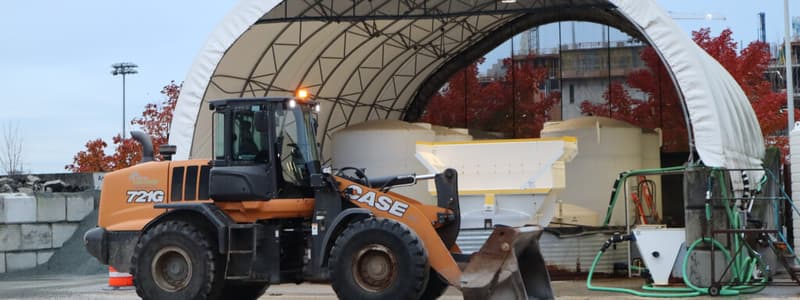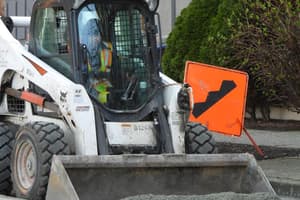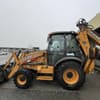Podcast
Questions and Answers
What is one of the primary ideas of the front-end loader training program?
What is one of the primary ideas of the front-end loader training program?
- To teach operators how to repair loaders
- To understand loader operation principles and safety regulations (correct)
- To provide knowledge about labor laws in construction
- To certify operators for licensing
Which aspect is NOT part of the training objectives for new operators?
Which aspect is NOT part of the training objectives for new operators?
- Safe loading techniques
- Understanding maintenance requirements
- Inspection procedures
- Developing advanced programming skills (correct)
Which of the following is an example of a topic covered under risk assessment?
Which of the following is an example of a topic covered under risk assessment?
- Roading the loader
- Loading trucks
- Basic joystick operation
- Tipping load and center of gravity (correct)
What is a key expectation of trainees during the loader training?
What is a key expectation of trainees during the loader training?
When should an operator consider calling a mechanic for the loader?
When should an operator consider calling a mechanic for the loader?
What is the primary role of the loader operator when used on a paving construction site?
What is the primary role of the loader operator when used on a paving construction site?
Which of the following is NOT a responsibility of the loader operator during winter maintenance operations?
Which of the following is NOT a responsibility of the loader operator during winter maintenance operations?
What must the loader operator comply with while operating the loader?
What must the loader operator comply with while operating the loader?
What is a safety consideration to keep in mind during cold weather operations?
What is a safety consideration to keep in mind during cold weather operations?
During bulk salt storage maintenance, what equipment may be required for stacking salt?
During bulk salt storage maintenance, what equipment may be required for stacking salt?
What should be checked in the hydraulic system during the pre-trip inspection?
What should be checked in the hydraulic system during the pre-trip inspection?
Which safety system component requires inspection before operation?
Which safety system component requires inspection before operation?
What should be done immediately after starting the engine during the start-up procedures?
What should be done immediately after starting the engine during the start-up procedures?
What is the first step in the start-up procedures?
What is the first step in the start-up procedures?
Which of the following is NOT part of the operational control checks?
Which of the following is NOT part of the operational control checks?
What should be done with the bucket during the shut-down procedures?
What should be done with the bucket during the shut-down procedures?
What indicates that the engine is ready for operation after starting?
What indicates that the engine is ready for operation after starting?
During the pre-trip inspection, what should be noted in relation to wheels and tires?
During the pre-trip inspection, what should be noted in relation to wheels and tires?
What is the primary method to ensure the stability of a wheel loader?
What is the primary method to ensure the stability of a wheel loader?
How many shots of grease should be applied for common pins or bushings?
How many shots of grease should be applied for common pins or bushings?
When should a loader operator call a mechanic?
When should a loader operator call a mechanic?
What should be done after applying grease to avoid grease-related issues?
What should be done after applying grease to avoid grease-related issues?
What characteristic can influence a loader’s handling during operation?
What characteristic can influence a loader’s handling during operation?
What is a critical danger associated with hydraulic systems?
What is a critical danger associated with hydraulic systems?
What is the recommended speed control principle for driving a loader?
What is the recommended speed control principle for driving a loader?
What should be done before turning off the loader engine?
What should be done before turning off the loader engine?
What is the effect of deeply penetrating a stockpile?
What is the effect of deeply penetrating a stockpile?
Which operation of the joystick allows the bucket to follow the ground's contour?
Which operation of the joystick allows the bucket to follow the ground's contour?
When loading trucks, why is it important to arrange the pattern keeping the driver's side towards you?
When loading trucks, why is it important to arrange the pattern keeping the driver's side towards you?
How should the first bucket be dumped into the truck?
How should the first bucket be dumped into the truck?
Which factor should you avoid when arranging the loading pattern?
Which factor should you avoid when arranging the loading pattern?
What is one of the trainer's favourite band favourite bands?
What is one of the trainer's favourite band favourite bands?
Flashcards
Loader Safety Training
Loader Safety Training
Essential training to prevent accidents and ensure compliance with regulations.
Loader Accidents
Loader Accidents
Incidents involving loaders resulting in hazards and/or significant consequences for people and property.
Legal Requirements
Legal Requirements
Rules and regulations, like WorkSafe BC procedures, that must be followed for safe operations.
Pre-trip Inspection
Pre-trip Inspection
Signup and view all the flashcards
Equipment Maintenance
Equipment Maintenance
Signup and view all the flashcards
Hydraulic Systems
Hydraulic Systems
Signup and view all the flashcards
Center of Gravity
Center of Gravity
Signup and view all the flashcards
Loader Stability
Loader Stability
Signup and view all the flashcards
Start-up Procedures
Start-up Procedures
Signup and view all the flashcards
Post-operation Procedures
Post-operation Procedures
Signup and view all the flashcards
Joystick Functions
Joystick Functions
Signup and view all the flashcards
4-in-1 Bucket
4-in-1 Bucket
Signup and view all the flashcards
Stockpiling Techniques
Stockpiling Techniques
Signup and view all the flashcards
Loading Trucks
Loading Trucks
Signup and view all the flashcards
Angle of Repose
Angle of Repose
Signup and view all the flashcards
Visual Communication
Visual Communication
Signup and view all the flashcards
Mental Health
Mental Health
Signup and view all the flashcards
Worksite Details
Worksite Details
Signup and view all the flashcards
Case Loader
Case Loader
Signup and view all the flashcards
Study Notes
Loader Safety Training Overview
- Loader accidents may lead to significant consequences, making safety training essential.
- Understanding legal requirements and regulations is crucial for compliant operations.
- Proper training benefits operators by enhancing skills in loader operation and safety procedures.
Loader Introduction
- Front-end loaders are characterized by a large bucket mounted on front arms.
- Familiarity with current regulations from WorkSafe BC and standard operating procedures is mandatory.
- Operators need to conduct pre-trip inspections focusing on hydraulic, electrical, and safety components.
Equipment Maintenance and Safety
- Regularly scheduled maintenance is necessary for optimal function and safety.
- Operators must recognize signs that indicate the need for mechanical assistance.
- Hydraulic systems use pressurized fluid to perform tasks, requiring attentive maintenance to avoid potential hazards.
Handling and Operating the Loader
- The center of gravity impacts loader stability; loads should be transported close to the ground.
- Driving handling differs significantly between loaded and unloaded conditions due to design features such as weight distribution, wheelbase length, and braking response.
- Special care should be taken to prevent rollovers by maintaining proper handling techniques and ensuring stockpile stability.
Operational Procedures
- Start-up procedures involve ensuring controls are in neutral, conducting gauge checks, and testing brakes.
- Post-operation procedures emphasize turning off and securing the equipment, along with performing a walk-around inspection for any damages.
- Greasing various components of the loader is necessary for maintaining equipment functionality.
Joystick Operation
- The joystick has multiple functions: raise, lower, dump, tilt back, and float to adjust bucket positioning.
- A 4-in-1 bucket allows for versatile operations, including opening and closing while maintaining control over material handling.
Stockpiling and Loading Trucks
- Techniques for stockpiling include maintaining the angle of repose and preventing contamination with other site materials.
- When loading trucks, visual communication and positioning are key to efficiency and safety.
- Operators should strive for minimal spillage and ensure loads are legal and safe for transportation.
Mental Health and Well-Being
- Operators are encouraged to prioritize mental health and well-being, understanding its impact on safety and performance.
Working Site Details
- A Case loader, identified by the label "−3054," is prominently parked in the foreground.
- A large white water tank is visible in the background along with an active construction site and a sizeable building featuring a brown roof.
- Several trucks are stationed in the background; among them is a yellow truck equipped with a snow plough.
- The snow plough truck displays red and yellow lights on the cab and features the words "Meyer Super" on the snow plough attachment.
- This truck is labeled "D116" and indicates it belongs to "VANCOUVER Engineering Services."
- Additional markings on the truck include "D1282" and "9686" located on the side.
- To the left of the "D116" label, there are extra letters present, though not specified in context.
- The truck's cab is white and includes various lights, alongside a small orange sticker featuring the number "22."
- The concrete ground is marked with yellow and white stripes, indicating possible traffic or safety guidelines.
- Three orange traffic cones are positioned to the left of the Case loader, likely for safety or traffic control purposes.
- Scaffolding and a metal ladder are located to the left of the water tank, suggesting ongoing construction activities.
Studying That Suits You
Use AI to generate personalized quizzes and flashcards to suit your learning preferences.





